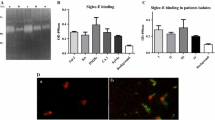Abstract
The transformation of Trypanosoma cruzi epimastigotes to mammal-infective metacyclic trypomastigotes (metacyclogenesis) can be performed in vitro under chemically defined conditions (TAU 3AAG medium). During this process, changes in the nature of cell surface sugar composition and sugar distribution was evaluated using FITC and gold-labeled lectins and observed by flow cytometry and transmission electron microscopy. The pattern of labeling with the lectins from Triticum vulgaris (WGA), Arachis hypogaea (PNA), Limax flavus (LFA), Canavalia ensiformis (Con-A), and Ricinus communis (RCA-I) significantly changed during the metacyclogenic process. The results obtained are discussed in relation to the role played by T. cruzi cell surface carbohydrate residues on the process of parasite–host cell interaction.
Similar content being viewed by others
Author information
Authors and Affiliations
Additional information
Accepted: 26 May 1998
Rights and permissions
About this article
Cite this article
Bourguignon, S., de Souza, W. & Souto-Padrón, T. Localization of lectin-binding sites on the surface of Trypanosoma cruzi grown in chemically defined conditions. Histochemistry 110, 527–534 (1998). https://doi.org/10.1007/s004180050314
Issue Date:
DOI: https://doi.org/10.1007/s004180050314




